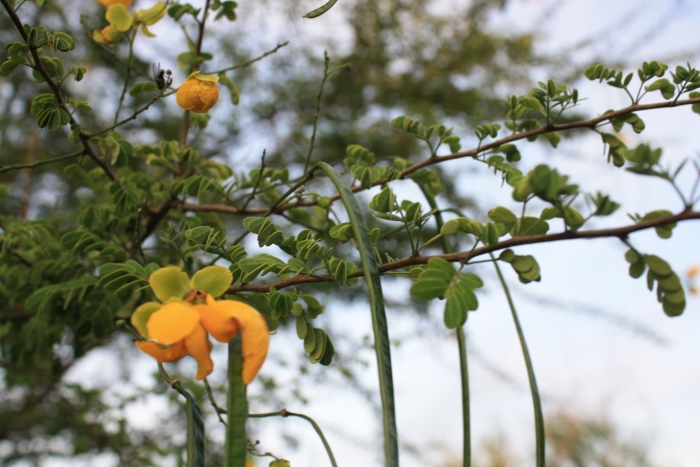Desert Senna
(Senna wislizeni)
Desert Senna (Senna wislizeni)
/
/

Rafael Cano
CC BY 4.0
Image By:
Rafael Cano
Recorded By:
Copyright:
CC BY 4.0
Copyright Notice:
Photo by: Rafael Cano | License Type: CC BY 4.0 | License URL: http://creativecommons.org/licenses/by/4.0/ | Rights Holder: Rafael Cano | Publisher: iNaturalist | Date Created: 2020-09-11T18:25:23-07:00 |




















Estimated Native Range
Summary
Senna wislizeni, commonly known as Desert Senna or Shrubby Senna, is a deciduous shrub native to arid environments such as desert washes, mesas, and slopes in the Southwestern United States and Northern Mexico. It typically grows to a height and width of about ten feet (3 meters), with a rounded form and compound, pinnate leaves that are green to gray-green in color. During the summer months, particularly in late summer, Desert Senna produces showy, bright yellow flowers that are attractive to pollinators such as carpenter bees and bumblebees. Following flowering, it develops distinctive long, flat, dark brown seed pods.
Desert Senna is valued for its drought tolerance and ability to thrive in harsh conditions, making it an excellent choice for xeriscaping and naturalistic plantings in arid regions. It is also used for erosion control on slopes and in reclamation projects. The plant’s ability to attract pollinators and serve as a larval food source for Sulphur butterflies adds to its ecological value in gardens. For successful cultivation, Desert Senna requires full sun exposure and well-drained soils. It is tolerant of low water conditions once established, making it a low-maintenance option for gardeners in suitable climates.CC BY-SA 4.0
Desert Senna is valued for its drought tolerance and ability to thrive in harsh conditions, making it an excellent choice for xeriscaping and naturalistic plantings in arid regions. It is also used for erosion control on slopes and in reclamation projects. The plant’s ability to attract pollinators and serve as a larval food source for Sulphur butterflies adds to its ecological value in gardens. For successful cultivation, Desert Senna requires full sun exposure and well-drained soils. It is tolerant of low water conditions once established, making it a low-maintenance option for gardeners in suitable climates.CC BY-SA 4.0
Plant Description
- Plant Type: Shrub
- Height: 4-8 feet
- Width: 4-10 feet
- Growth Rate: Moderate
- Flower Color: Yellow
- Flowering Season: Summer
- Leaf Retention: Deciduous
Growth Requirements
- Sun: Full Sun
- Water: Low, Medium
- Drainage: Fast
Common Uses
Bee Garden, Bird Garden, Butterfly Garden, Low Maintenance, Showy Flowers
Natural Habitat
Arid environments such as desert washes, mesas, and slopes in the Southwestern United States and Northern Mexico
Other Names
Common Names: Wislizenus’ Senna, Canyon Senna, Wislizenus’ Wild Sensitive Plant
Scientific Names: , Senna wislizeni, Cassia wislizeni, Palmerocassia wislizeni,
GBIF Accepted Name: Senna wislizeni (A.Gray) H.S.Irwin & Barneby